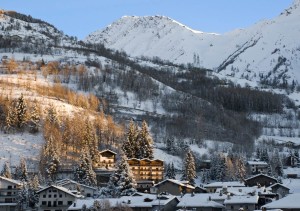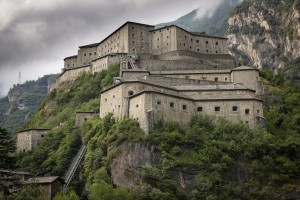The private association “I borghi più belli d’Italia” (“The most beautiful places in Italy”) was founded in 2001 with the mission to present and support particularly beautiful places in Italy. These places – small towns and villages – are prevalently situated beyond beaten touristic paths and are at risk of falling into oblivion. Many of them are of medieval of origin, even car-free, have a distinct charm and a harmonious townscape. You can find two such places in the Aosta Valley in the northwesternmost part of the country; places you absolutely should learn more about.
Étroubles

©Bigstock.com/emanisca
The first stop is Étroubles. You’re in the French-speaking part of the country, as the name suggests. At just under 500 inhabitants and a rather large area of about 39 km², Étroubles is a classic mountain village in the Western Italian Alps. Situated along the Great St Bernard Pass, its history can be traced back to Roman times. As such, Étroubles’ name likely derives from Latin and Occitan terms for “straw” and “fields of straw”, neatly describing the village’s magnificent surroundings.
Old customs and traditions remain important in Étroubles. The Veillà focuses on the old village life ranging from traditional crafts to agriculture to everyday social life. The cuisine reflects all of that including the fried dessert “bugie” and the rustic “seuppa freida” (stale brown bread dunked in red wine). One of the highlights in carnival season is an ironic procession satirising Napoleon’s march through the village.
Putting aside these amazing traditions and festivities where you will be most certainly welcomed with open arms, there are also some sights in Étroubles you need to check out:
- Parish church: First mentioned in the Middle Ages, today’s church Santa Maria Assunta is far more modern as it was only built in 1815. Rocks of the former building were used for the new structure, but the belltower still maintains its Romanesque roots.
- Torre di Vachéry: This tower was originally built as a lookout for the local defence system during the 12th century and later adapted as a residence. Burnt down during the Second World War and slowly restored ever since, Torre di Vachéry represents the medieval structures of Étroubles.
- Open-air museum: An art project dating back to 2005 brings together the charming townscape and the surrounding mountains. 21 renowned artists turned house walls throughout the village into one giant open-air museum accompanying you on your walks through Étroubles.
Bard

©Bigstock.com
Situated at the river Dora Baltea, Bard is dedicated to maintaining the cultural heritage of the Aosta Valley. Due to its ideal location in the narrow gorge, the area was already populated during the neolithic period and later became part of a road connecting Celtic Gaul and Roman territories. As such, the name likely derives from the Celtic “bar”, a fortress or fortified area. You probably won’t be surprised to hear that Bard (approx. 120 inhabitants, 3 km² total area) played quite a significant role as a defensive fortification throughout history even halting a surprise attack by the French army in May 1800 for quite some time.
Rather surprisingly for such a narrow strip of land, there’s some winegrowing happening on the terrace along the former Roman road. Regional winegrowers are very tenacious and seemingly unfazed by the adverse location with its tall rock formations. An intense red wine extracted from the Nebbiolo grape with a slight almond flavour delights the palate. Other regional specialities include the cookies “paste de meglia” made of corn flour and the popular Christmas broth “bœuf de Noël”.
There’s also many a treasure waiting for you in Bard:
- Forte di Bard: Initial fortification structures can be traced back as far as the Ostrogoths in 6th century, but it was the Counts of Aosta and Savoy who had the fort expanded. Blown up and destroyed per decree of Napoleon after French troop progressions had been halted here, the majestic structure was rebuilt in the 1830s. It currently houses several museums and exhibitions, such as the amazing Museo delle Alpe presenting the history and nature of the Western Alps.
- Parish church: Naturally, Bard has its own church with quite a few similarities to the one in Étroubles: dedicated to the Assumption of Mary, originally a medieval structure, and rebuilt during the 19th The belltower, again, managed to keep its Romanesque flair.
- Surroundings: There are several smaller villages around Bard that lend themselves to touring the region. Medieval Albard and the rock houses of Crous amidst chestnut trees are particularly impressive. Don’t miss out on a trip to the enchanting Tête de Cou with its astonishing view.
The Aosta Valley is home to stunning places which are, like the region itself, overlooked and neglected far too often. Actually, however, Italy’s magical northwest is always worth a visit. Discover these and other magical places of the country during your next holiday and let yourself be enchanted by their pristine charm!